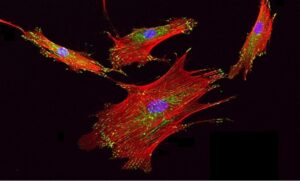
(Google Images, Creative Commons License)
STEM Cells: A Future Medical Miracle
Stem cells are cells that have the potential to differentiate into any different cell per need of an organism. Most commonly they are used in the growth and development of embryo. Stem cells are very important for the future of medical practices. “Why?” you may ask. It is because stem cells pave the road for new regenerative medicines and therapies, as they can become any cell, and thus repair and part of the body. This experimental study is focused on results that relate to the application of stem cells for regenerative medicine.
The overall research questions that this study aimed to answer were to see if a skin graft could be an effective way to use the stem cells, to see how well the stem cell implemented skin graft could work on wound healing, and to discover how well the stem cells could differentiate for wound healing in the diabetic rats. The questions were meant to be answered through studying the effect of stem cell treated skin grafts on wound healing in rats. These research questions weren’t in response to any particular study but were rather stemmed from the general trend in stem cell research. They contribute toward the trend of discovering how to apply stem cell research to medicinal use.
There was a long process in order to apply the stem cells to the skin grafts. The stem cells used in this experiment were adipose derived, so the first step to obtain the skin cells was to obtain inguinal fat from the rats. This adipose was then kept in the cold, layers were removed, it was treated with numerous chemicals, and it was centrifuged to separate particles. Finally, cells were cultured from the samples and were ready to be differentiated with the skin grafts. The regular skin grafts were prepared through scaffolds being treated with various substances and cutting. For the stem cell treated skin grafts, they were additionally prepared by seeding the skin grafts with the adipose derived stem cells at a particular density, and then set for incubation to ensure the stem cells cultivated within the graft.
To set up the experiment, first 36 rats were obtained. The rats were given streptozotocin injections that would manifest diabetes. Diabetes was manifested in the rats for the purpose of observing how the treatment would work with the presence of a chronic condition that can lead to more wounds. The rats were separated into three groups, a group with a skin graft that incorporated adipose-derived stem cells, a regular skin graft, and no graft (the control group). A cutaneous laceration was made on all the backs of the rats to be the wound that was subject of observation. The rats in the different groups received the appropriate treatment that correlated to the group they were in. The treated wound was then covered in a Vaseline oil gauze.
On days 3,7, 14, and 21, the samples of injured tissue were retrieved from each subject in order to be used for analysis. On those days, a digital camera was also used to observe the wounds and from that, the observable area was used to calculate the wound healing rate. The equation was used to calculate the wound healing rate by comparing the area of the current wound with the area of the original wound and days that passed.
The results of the study came back showing that the stem cell applied skin graft had promising results. The stem cell treated skin graft showed a higher rate of epithelialization, more tissue formation, and more capillary formation when compared to the other groups. The skin graft group had regenerated new tissue that was very similar to the original tissue by the 21-day mark. Despite the results, the stem cell seeded skin graft wasn’t able to completely get rid of all the inflammation and collagen that was present in and near the wound. But overall, the stem cells performed very well to heal the wound.
Overall, the study provided positive data for the future of regenerative medicine. It provided data to back up the effectiveness of stem cell derived technology in the application of healing wounds. This opens up many new possibilities for future research of stem cells in regenerative medicine. Eventually, this line of research may reach a point where the breakthrough with human regenerative medicine is achieved. An important note is that the effectiveness of the stem cells was observed in diabetic rats, and not just regular rats. This indicates that despite the health limitations for healing and skin properties that the rats had because of their diabetic state, the stem cells prevailed and healed the wound. The effectiveness of the stem cells with the diabetic rats shows how it versatile and strong the treatments can be, which promises great potential for the future of regenerative medicine. At this rate of research, there may be some day where no injury or illness will be able to surpass the regenerative capabilities of stem cells in future medical practice.
References
Wu Y-Y, Jiao Y-P, Xiao L-L, Li M-M, Liu H-W, Li S-H, Liao X, Chen Y-T, Li J-X, Zhang Y. May 2018[accessed 2/11/21]. Experimental study on effects of adipose-derived stem cell–seeded silk fibroin chitosan film on wound healing of a diabetic rat model. Annals of Plastic Surgery.;80(5), 572-580. https://oce.ovid.com/article/00000637-201805000-00022/HTML